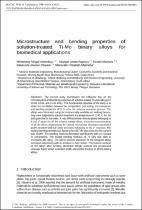 ResearchSpace
ResearchSpace
Microstructure and bending properties of solution-treated Ti-Mo binary alloys for biomedical applications
JavaScript is disabled for your browser. Some features of this site may not work without it.
- ResearchSpace
- →
- Research Publications/Outputs
- →
- Journal Articles
- →
- View Item
| dc.contributor.author |
Moshokoa, Nthabiseng A

|
|
| dc.contributor.author |
Raganya, Mampai L

|
|
| dc.contributor.author |
Machaka, Ronald

|
|
| dc.contributor.author |
Obadele, BA

|
|
| dc.contributor.author |
Mamookho, ME

|
|
| dc.date.accessioned | 2023-05-12T11:11:50Z | |
| dc.date.available | 2023-05-12T11:11:50Z | |
| dc.date.issued | 2022-11 | |
| dc.identifier.citation | Moshokoa, N.A., Raganya, M.L., Machaka, R., Obadele, B. & Mamookho, M. 2022. Microstructure and bending properties of solution-treated Ti-Mo binary alloys for biomedical applications. http://hdl.handle.net/10204/12772 . | en_ZA |
| dc.identifier.uri | https://doi.org/10.1051/matecconf/202237003014 | |
| dc.identifier.uri | http://hdl.handle.net/10204/12772 | |
| dc.description.abstract | The current study investigates the influence Mo on the microstructure and bending properties of solution treated Ti-xMo alloys (x= 10.00, 12.89, and 15.05 wt%). The fundamental objective of the study is to attain the correlation between the composition, processing, microstructure, and bending properties of ß Ti after the solution treatment process. The alloys were fabricated using the commercially available arc melting furnace, they were subjected to solution treatment at a temperature of 1100 for 1hr and quenched in ice water. X-ray diffractometer showed peaks belonging to ß and a phase for all the solution treated alloys, while the microstructures of all the alloys characterized by Optical microscope illustrated equiaxed ß grains structure and sub-grain structures belonging to the a structure. The highest bending strength was found to be 1627.40 Mpa when the Mo content was 15wt%. The bending modulus decreased significantly with an increase in composition. The lowest bending modulus of 74 GPa was seen in 15.05wt% Mo alloy. The Micro-Vickers Hardness of the designed alloys increased extensively with an increase in Mo content. The fracture surfaces of the alloys after bending illustrated dimple features and pronounced cleavage facets which indicated brittle and ductile fracture in all the binary alloys. | en_US |
| dc.format | Fulltext | en_US |
| dc.language.iso | en | en_US |
| dc.relation.uri | https://www.matec-conferences.org/articles/matecconf/abs/2022/17/contents/contents.html | en_US |
| dc.source | 23rd Annual International RAPDASA Conference joined by RobMech, PRASA and CoSAAMI, Somerset-West, Cape Town, 9-11 November 2022 | en_US |
| dc.subject | Ti-xMo alloys | en_US |
| dc.subject | Ti-Mo binary alloys bending properties | en_US |
| dc.subject | X-ray diffractometers | en_US |
| dc.title | Microstructure and bending properties of solution-treated Ti-Mo binary alloys for biomedical applications | en_US |
| dc.type | Conference Presentation | en_US |
| dc.description.pages | 12pp | en_US |
| dc.description.note | © The Authors, published by EDP Sciences. This is an open access article distributed under the terms of the Creative Commons Attribution License 4.0 (http://creativecommons.org/licenses/by/4.0/). | en_US |
| dc.description.cluster | Manufacturing | en_US |
| dc.description.impactarea | Powder Metallurgy Technologies | en_US |
| dc.identifier.apacitation | Moshokoa, N. A., Raganya, M. L., Machaka, R., Obadele, B., & Mamookho, M. (2022). Microstructure and bending properties of solution-treated Ti-Mo binary alloys for biomedical applications. http://hdl.handle.net/10204/12772 | en_ZA |
| dc.identifier.chicagocitation | Moshokoa, Nthabiseng A, Mampai L Raganya, Ronald Machaka, BA Obadele, and ME Mamookho. "Microstructure and bending properties of solution-treated Ti-Mo binary alloys for biomedical applications." <i>23rd Annual International RAPDASA Conference joined by RobMech, PRASA and CoSAAMI, Somerset-West, Cape Town, 9-11 November 2022</i> (2022): http://hdl.handle.net/10204/12772 | en_ZA |
| dc.identifier.vancouvercitation | Moshokoa NA, Raganya ML, Machaka R, Obadele B, Mamookho M, Microstructure and bending properties of solution-treated Ti-Mo binary alloys for biomedical applications; 2022. http://hdl.handle.net/10204/12772 . | en_ZA |
| dc.identifier.ris | TY - Conference Presentation AU - Moshokoa, Nthabiseng A AU - Raganya, Mampai L AU - Machaka, Ronald AU - Obadele, BA AU - Mamookho, ME AB - The current study investigates the influence Mo on the microstructure and bending properties of solution treated Ti-xMo alloys (x= 10.00, 12.89, and 15.05 wt%). The fundamental objective of the study is to attain the correlation between the composition, processing, microstructure, and bending properties of ß Ti after the solution treatment process. The alloys were fabricated using the commercially available arc melting furnace, they were subjected to solution treatment at a temperature of 1100 for 1hr and quenched in ice water. X-ray diffractometer showed peaks belonging to ß and a phase for all the solution treated alloys, while the microstructures of all the alloys characterized by Optical microscope illustrated equiaxed ß grains structure and sub-grain structures belonging to the a structure. The highest bending strength was found to be 1627.40 Mpa when the Mo content was 15wt%. The bending modulus decreased significantly with an increase in composition. The lowest bending modulus of 74 GPa was seen in 15.05wt% Mo alloy. The Micro-Vickers Hardness of the designed alloys increased extensively with an increase in Mo content. The fracture surfaces of the alloys after bending illustrated dimple features and pronounced cleavage facets which indicated brittle and ductile fracture in all the binary alloys. DA - 2022-11 DB - ResearchSpace DP - CSIR J1 - 23rd Annual International RAPDASA Conference joined by RobMech, PRASA and CoSAAMI, Somerset-West, Cape Town, 9-11 November 2022 KW - Ti-xMo alloys KW - Ti-Mo binary alloys bending properties KW - X-ray diffractometers LK - https://researchspace.csir.co.za PY - 2022 T1 - Microstructure and bending properties of solution-treated Ti-Mo binary alloys for biomedical applications TI - Microstructure and bending properties of solution-treated Ti-Mo binary alloys for biomedical applications UR - http://hdl.handle.net/10204/12772 ER - | en_ZA |
| dc.identifier.worklist | 26571 | en_US |





